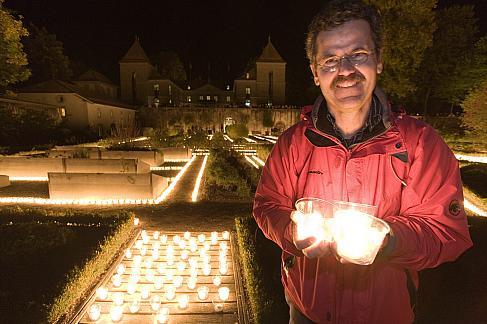What does your art consist of? How would you describe your artistic work?
As an artist, I’ve got two sides. The first is a private, artistically more normal side, in which I devote myself to painting, drawing and works on paper… Then I’ve got a more outward-going side, with which I carry out social actions, social sculptures, which consist of making a participative artwork in which the main material is human energy, social and co-operative energy. In social sculptures, I use fire as an artistic element. Fire is the first technology that prehistoric man succeeded in controlling 400,000 years ago. Since then, fire has fostered interpersonal relations, it creates groups. The social realm and fire are deeply rooted in human nature. For example, in the Middle Ages, due to the high death rate at the time, the population was counted not in the number of homes but in the number of hearths, in other words, family units.
Each social action is a unique project and even though candles might be the element common to all of them, it is the territory I work in that defines the needs of each project. I reinterpret the territory, giving it content through the forms and through the message I convey to the volunteers helping me to carry out the project. If the territory is very large, there may be thousands of candles. In the largest piece I’ve ever produced, which was in 2006 in Lausanne in Switzerland, I used 127,444 candles, one for each of the residents of Lausanne. That project was called Allumons Lausanne! (Let’s Light Up Lausanne!). The second largest was in Barcelona in 2009, a collective piece entitled Encenguem la mar(Let’s Light Up the Sea), in which 119,000 candles were used and in which there were almost 1,200 volunteers.
You mentioned your two artistic sides, one that is more traditional, more private, and the other that is more outgoing, which is the one that appears when you’re making social sculptures. How did you get from one side to the other?
I arrived at this conclusion, the decision to carry out social actions, in 2001 to 2002, when the concept of the indignats[1]was not yet fashionable. You might regard me as anindignat then and that I still am. When my second side emerged, Spain was in a state of ‘galloping Aznarism’,[2]there was the controversy over the Prestige,[3] the war in Iraq, and the feeling I got was that producing an intellectual discourse, a manifesto, articles in newspapers, was pointless, since this kind of action was preaching to the converted. As I see it, an artist is viable inasmuch as he is capable of finding the language, the formula to overcome that kind of problem. Fire was, and still is, a very moving thing that could and still can place citizens at the heart of things without difficulties, providing a metaphor for real power, which is the power of the people. The first action I did was in Girona, where I placed a candle for every resident. At that time, there was no point explaining to people the things that the government was doing badly; the most important thing was to find a way of kindling a social consciousness. I lived and still live in Switzerland, where there is a very strong tradition of direct democracy, though I’m not sure that this concept is as clear in Catalonia and Spain.
You’ve gone from living in Ciutat Vella, the old town, in Barcelona, to living in Lausanne in Switzerland by going on a long journey to India on a bicycle. How has this journey influenced your art?
Candles are a direct consequence of my travels. In 1984, I set off on a journey round south-east Asia on a bicycle and on my return I settled in Lausanne. During the journey, I came across the Diwali (Festival of Lights) at Pokhara (Nepal). For the festival, which is held in autumn, all the lights in the city are switched off and then thousands of candles are lit. This gave me the idea of using fire in my interventions. A human and urban landscape lit by street lighting is completely different; with candles, it becomes magical, strange. Flames make a landscape we are familiar with become real and we are able to discover it anew.
You’ve been living in Switzerland for over 25 yeas. Do you miss Catalonia?
I went to live in Switzerland for three reasons. The first was personal, a matter of love; the second reason was because I wanted to study abroad; and the third was an artistic motive. At the artistic level, Switzerland is extremely well placed, right in the middle of Europe. It has a large art market and major collectors. Moreover, Catalonia is getting closer all the time: thanks to the new technologies, I have access to a lot of Catalan culture and I feel involved in everything that goes on here.
How do you see the art scene in Catalonia? Do you think that art is appreciated as a discipline in our country?
Cataloniais rich in artists but it has a poor art market. It is increasingly difficult to be an artist in Catalonia, and most Catalan artists end up showing their work abroad. When I say that art is not appreciated as a disciplinein Catalonia, I don’t mean just at an institutional level, as civil society is responsible for it as well.
What are your projects for the future?
To carry on producing social actions. The next social sculpture is on 17 May in Carouge, Geneva, where I’ll be presenting theCurcubitaArdens project, which is also a social sculpture that involves fire. In addition, I’ll be presenting the exhibition of paintings Cygnes & Signes in Geneva on 30 May. Even so, as I said, I want to carry on working with fire and social sculptures because that’s what motivates me and it’s what I’m known for, it’s my personal brand. I started out as a conventional artist and I’ve ended up as a performance artist, though I combine the two things.
You can see an example of the social sculptures made by Muma in the following video
[1]Translator’s note: The indignats(indignant) are a movement of people that emerged in 2011 and which is seeking radical change in Spanish politics and society.
[2]Translator’s note: Named after José Maria Aznar, a former prime minister of Spain who led the right-wing Partido Popular (People’s Party).
[3]Translator’s note: An oil tanker that sank off the coast of Galicia in 2002and caused an oil spill that polluted thousands of kilometres of coastline.







